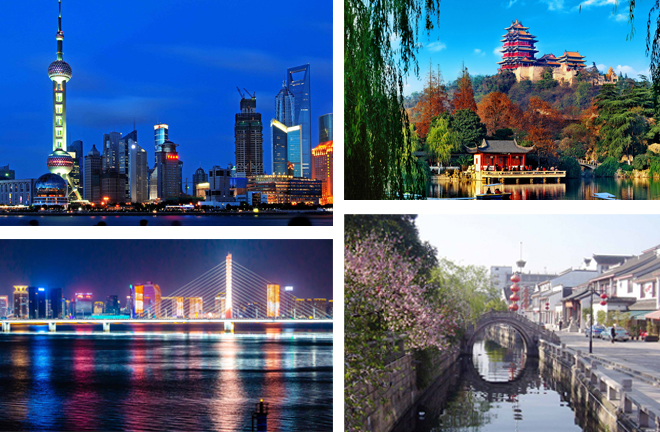Urban agglomeration gaining more momentum in China

Shanghai, Nanjing, Hangzhou and Suzhou are part of the Yangtze River Delta City Cluster, one of the top five urban agglomerations with the highest levels of development in China.
Making steady progress in the new era, urban agglomeration has been a hot topic during the NPC and CPPCC, the annual meetings of China’s top legislative and political advisory bodies collectively known as the “Two Sessions.”
Urban agglomeration has been the trend of global urban development and also the “main form” of China’s new urbanization, said Cheng Changchun, director of the Jiangsu Yangtze River Economic Belt Research Institute.
At present, the top five urban agglomerations with the highest levels of development in China are the Yangtze River Delta City Cluster, the Beijing-Tianjin-Hebei City Cluster, the Pearl River Delta City Cluster, the Middle Yangtze River City Cluster and the Chengdu-Chongqing City Cluster. “Not only highly developed in industrialization, informatization, urbanization, the internet and the internet of things, these urban agglomerations are also the major motivation for China's economic globalization, its convergence with the international community, and promotion of the ‘Belt and Road’ initiative,” said Cheng.
In addition, other agglomerations have also emerged in recent years, including the Central Plains City Cluster, the Harbin-Changchun City Cluster, the city cluster of Central and Southern Liaoning, the Shandong Peninsula City Cluster, the city cluster on the western shore of the Taiwan Straits, the Beibu Gulf agglomeration, and the Guanzhong agglomeration.
“The rise of new urban agglomerations is a result of the spontaneous evolution of urban development and influence of administrative forces,” said Huang Kainan, director of the Institute for Studies in County Development at Shandong University.
In recent years, China has experienced high-speed urbanization, with large numbers of rural people moving to cities. Urban areas continue to expand, traffic infrastructure and markets continue to improve, and the organic connections between cities have become even closer.
In this context, a strategy of urban agglomeration has developed involving the formation of city groups to promote a reasonable division of labor among cities and the integration of inter-city markets and infrastructure, reduce the transaction costs of inter-city resource flows, and make better use of the space spillover effect between cities, Huang said.
With the transformation of China’s major social contradictions and the new tasks such as the construction of a modern economic system and the implementation of strategies of coordinated regional development, the concepts, models and paths of urban agglomeration in China will change at varying degrees.
In the next step, the concept of urban agglomerations will be adjusted. The differences between wide-area and narrow-area urban agglomerations will also be diluted, which will gradually develop into a metropolitan area or a new type of inter-city economic system under the general trend of integration, said Zhao Guangyuan, deputy director of the City Development Research Institute at Jilin Academy of Social Sciences.
The purpose of urban agglomeration is to optimize the industrial layout and increase productivity. Urban agglomeration also has an important task of promoting more efficient innovation. Successful experiences around the world have shown that innovation has a spatial diffusion effect. The flow of innovative elements between cities can promote industrial development and enable the positive and sustainable development of urban agglomerations, Huang said.
Zhao said the concentration of population, the connection of capital, and the guarantee of culture are the three elements that drive urban agglomerations. Capital, environment, innovation, geography and the government are the five key factors that facilitate further urban agglomerations.
Judging from the practice at home and abroad, all developed urban agglomerations have a sound capital and financial system. Capital is the key to invigorating the various elements of the entire society, while the environment is to retain capital and enhance efficiency, ensuring cities seek harmony but not uniformity in a good environment of competition and cooperation.
The ability to innovate and attract talent is also an important indicator of urban agglomeration. At present, new mechanisms, technologies and concepts are reshaping the geographical pattern in cities. The influence of natural conditions on urban agglomerations is constantly being weakened. At the same time, the strength of the government should not be overlooked, Zhao said,
(edited by JIANG HONG)
